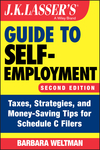Standard Deduction for a Home Office
If you use a portion of your home for business so that you qualify for a home-office deduction, you now can use a safe harbor amount rather than figuring the actual expenses related to the office. The IRS has introduced what amounts to a standard deduction for a home office starting in 2013 (it cannot be used on 2012 returns). The safe harbor amount is $5 per square foot, up to a maximum of 300 square feet. Thus, the maximum deduction is $1,500 ($5 ´ 300).
If you use the safe harbor, you cannot separately deduct depreciation or other home-office expenses (other than amounts such as home mortgage interest and real estate taxes that are deductible without regard to a home office). Expenses unrelated to operating the home office, such as advertising, wages, and supplies, continue to be separately deductible.
The election can be made on a year-by-year basis. However, once you use it for a particular year, the election is irrevocable.
In order to use this optional deduction amount, you must still qualify for a home office. Typically, this means using a portion of your home regularly and exclusively as your principal place of business (there are some other ways to qualify). And the safe harbor amount cannot exceed the gross income derived from the business operating in the home office. Any amount in excess of gross income cannot be carried forward; it is lost forever. What’s more, any carryover amounts from a year in which the actual expense method was used is also disallowed and cannot be claimed (the total home office deduction cannot exceed the safe harbor amount).
Caution: If you are an employee who receives reimbursement for home-office expenses, you cannot use the safe harbor method.
Source: Rev Proc 2013-13
Fiduciary
A person or corporation such as a trustee, executor, or guardian who manages property for another person.



